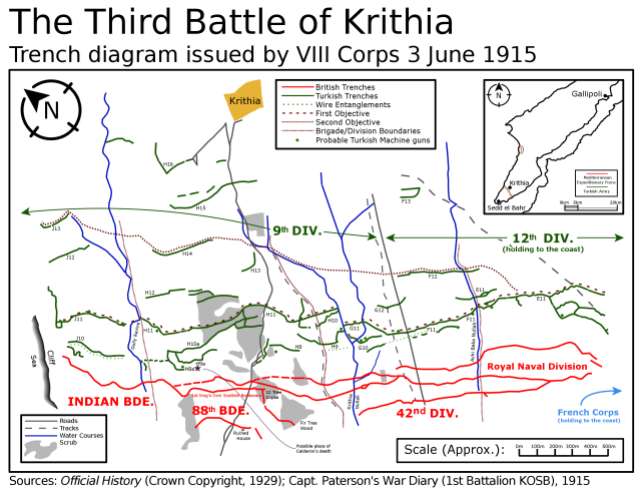At nine o’clock last night the 1st Battalion King’s Own Scottish Borderers paraded near W Beach, received a benediction from their padre, and were addressed by their commanding officer. They had been taken from the 87th Brigade and attached to the 88th, which included the 2nd Hampshire, 2nd Royal Fusiliers, 4th Worcestershire and 1/5th Royal Scots, with the 1st Essex in reserve. They now moved up Gully Ravine as they had the night before, but this time were taken to their position in the trenches. The 1st KOSB extended from the middle of Twelve Tree Copse on the right to the edge of a long strip of scrub on the left. The Royal Fusiliers were to their right, the Worcesters to their left. They spent the night mainly in support trenches. This is the trench diagram issued with orders on 3 June, but simplified by removing communication trenches and features such as orchards:
The sun rose this morning in a cloudless sky and it was obviously going to be a beautiful summer’s day. There was a fresh breeze from the north-east.
The orders for the battle were tabulated thus:
8 a.m. to 10.30 a.m.: Bombardment of strong-points. Final registration by field batteries.
11.05 to 11.20 a.m.: Bombardment of enemy front line.
11.20 to 11.30 a.m.: All guns cease fire, except those on enemy’s line of approach. Infantry cheer, and show fixed bayonets above trenches to induce the enemy to man his parapets.
11.30 to noon: Intensive bombardment of enemy front line.
12.00 noon: Batteries increase their range. Infantry, first wave, assault 1st objective.
12.15 p.m.: Infantry, second wave, assault 2nd objective.
At 6.00 a.m. the 1st KOSB’s adjutant, a Captain Paterson, went round the trenches. ‘Everyone’, he recorded in his diary, ‘seemed to understand their jobs’. At 8.00 the howitzers started registering and the troops had breakfast. Paterson describes the bombardment of strong-points as ‘tentative […] all the morning’, only ‘warming up’ between 11.00 and 11.25 when the Turkish front line was the target. The wind was now stiffening and blowing a thick cloud of fumes and dust back to the KOSB trenches. At this point the troops performed their ‘feint’ of cheering and showing their fixed bayonets above the parapet. ‘There was no doubt’, Paterson wrote, that the Turks were in their fire trenches, ‘as I have never heard such heavy rifle and machine gun fire.’ The ‘intensive’ bombardment of those trenches then resumed.
Platoon No. 8, commanded by George Calderon, was in support trenches on the extreme left of the KOSB line, touching the strip of scrub. It would be in the first wave of assault, comprising A and B Companies. George seems to have given his men a tot of brandy each. A witness statement dated 13 July 1915 says that he then ‘picked the leaf of a certain shrub, and told the men to do the same and to chew the leaves, as these were said by the Turks to give vigour. All the men near picked leaves and chewed them’.
At 11.55 they moved up into the fire trench that they had prepared on the night of the 2nd. ‘The Turkish fire’, wrote Paterson, ‘was still very heavy’. The first wave was to go over the top in two consecutive lines, A Company first on the right, B on the left. A Company mounted the ladders. At noon the whistle went and they leapt over the sand bags. Simultaneously, Turkish machine-guns opened fire right along the top of the parapet. As an eye witness, Sergeant-Major Daniel Joiner, put it, ‘instead of going forward, [A Company] either fell back again wounded or killed’. There was a lull in the fire, within seconds the whistle went again, and George led his men forward in B Company.

The 1st Battalion King’s Own Scottish Borderers go over the top at noon in the Third Battle of Krithia, 4 June 1915. Published by kind permission of the Imperial War Museum.
From where we stand on this side of the parapet, George had ‘vanished in the smoke of battle’, as so many of his friends later put it.
But it is the job of a biographer to go with his subject to the very end. George’s first biographer, Percy Lubbock, understood this and stated: ‘George was seen to fall, severely wounded, in the open. He was close to a Turkish trench, however; [so] there was a chance that he might prove to be a prisoner.’ But this was a vain hope.
Exhaustive study of all the published and unpublished evidence suggests that George, with his superior running skills, managed to get over a hundred yards towards the nearest Turkish trench, H9a, with men falling all around him. The trench itself was about another thirty yards ahead. At this point, I believe, he was hit by machine gun fire from H8a, in the Worcesters’ sector, or even H8 on the far right, as Paterson says that ‘all our losses had been caused by cross-fire from the flanks’. Only one officer from B Company survived.
This officer, and the witness whose statement was dated 13 July, believed that George was killed outright. I agree, and naturally I hope it was so. According to Paterson, ‘nearly all the corpses we got were hit six or seven times’.
Next entry: 4/5 June 1915
























Rest in Peace George.
Him now as of old I see
Carrying his head with an air
Courteous and virile,
With the charm of a nature free,
Daring, resourceful, prompt,
In his frank and witty smile.
By Oxford towers and streams
Who shone among us all
In body and brain so bold?
Who shaped so firm his themes
Crystal—hard in debate?
And who hid a heart less cold?
(Laurence Binyon)